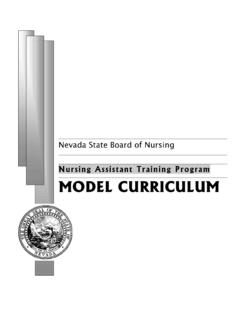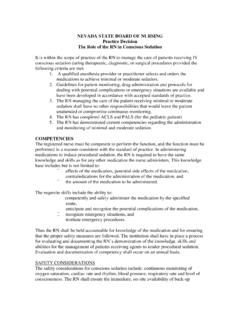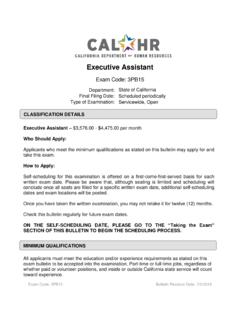Transcription of Nursing Assistant Training Program MODEL …
1 Nevada State Board of Nursing Nursing Assistant Training Program MODEL curriculum ACKNOWLEDGMENTS Special recognition and appreciation is extended to Elda Burke, RN and Kristine Beck, RN for their work in preparing the draft for this revision. Also, thanks to other members of the CNA Advisory Committee, both past and present, who were instrumental in bringing this publication to fruition. And to Patty O Rourke-Langston, MHA, RN, for proofreading, exerting calibrated pressure and the loan of her Assistant , Jeanie Jenkins, who provided clerical support. And finally, thanks to Patty Towler, CNA Specialist, for her unrelenting encouragement . MODEL curriculum adopted by Nevada State Board of Nursing November 1989 Revised: February 1990 March 1992 November 1993 November 1999 November 2004 November 2005 August 2006 i The Nursing Assistant Training MODEL curriculum Guide INTRODUCTION The Nursing Assistant Training Program MODEL curriculum was designed to provide a guide for instructors and learners on the competencies needed by Nursing assistants caring for clients in a variety of settings.
2 The MODEL curriculum meets the requirements of the Omnibus Reconciliation Act of 1987 (OBRA, CFR 42) and Nevada Revised Statute 632. LENGTH OF Program The curriculum is divided into 18 units, which include objectives, vocabulary and suggested content. The Program must be a minimum of 75 hours. Classroom and laboratory work must be a minimum of 60 hours. OBRA requires a trainee complete a minimum of 16 hours Training before being allowed to work in a facility. These 16 hours should include the following: Communication and Interpersonal Skills Infection Control Safety/Emergency Procedures, including abdominal thrusts Promoting Residents Independence Respecting Residents Rights GOALS OF THE INSTRUCTIONAL Program The goals of the instructional Program contained in this guide are: 1.
3 To introduce the learner to the health care field of Nursing assistants. 2. To provide learners with experiences in the classroom and in the clinical areas that result in development of basic competencies required of Nursing assistants. 3. To provide the learner with competencies that are prerequisite to specific areas and job entry. 4. To provide the learner with Training required by State and Federal laws for employment as a Nursing Assistant . 5. To provide learners who have completed a Nursing Assistant Training Program with the opportunities to update their skills. NOTE: Use of Standard Precautions, correct body mechanics, provision of privacy, maintaining confidentiality and proper use of side rails are expected to be integrated into all content and skills used in this manual.
4 Therefore, they are not specifically addressed in each unit. The word client will be used throughout the curriculum to refer to the person/patient/resident receiving care. ii GRADING OF LEARNERS Grading for each unit follows: Minimum of 80% on all written and oral quizzes/tests Minimum of 100% (pass/fail) on all skills listed in Appendix A Learners are permitted to practice skills until 100% accuracy is achieved. The test of skills must be given by a Registered Nurse who holds an instructor certification. Retakes are permitted on all oral or written quizzes/tests, up to two (2) times. The competency-based curriculum allows for variation in completion time because of the differences in individual learners. DOCUMENTATION OF COMPLETION Individuals wishing to certify as a Nursing Assistant must apply to the Nevada State Board of Nursing and qualify to take the Program and the State competency testing for certification.
5 Each individual who completes the Program should be awarded a document of completion by the agency administering the Program . The document means only that the learner has successfully completed the Nursing Assistant Training Program . General Evaluation Information: I. Evaluation Criteria A. Skills: 1. Learner will demonstrate performance in a professional manner using appropriate communication and respect for clients rights. 2. Learner will achieve 100% on skills in order to pass. Unprofessional, unsafe or abusive behavior in testing will constitute a failure of the test. B. Written/Oral: Learner will achieve a minimum of 80% on oral/written exam. II. Unit Quizzes Written/oral and manual quizzes should be completed at the end of each unit.
6 Employer should be notified of skills successfully passed. III. Final Exams The final exam consists of two (2) parts: written (or oral) and manual skills, according to the Training Program s state-approved application. iii Nursing Assistant Program WITH BEHAVIORAL OBJECTIVES Unit 1: The Role and Responsibility of the Nursing Unit 2: Communication and Interpersonal Relationships .. 2 Unit 3: Safety and Infection Control .. 3 Unit 4: Anatomy and Physiology Subunit A: Musculoskeletal 4 Subunit B: The Urinary System .. 5 Subunit C: The Integumentary System .. 6 Subunit D: The Cardiovascular System .. 7 Subunit E: The Respiratory 8 Subunit F: The Endocrine 9 Subunit G: The Sensory 10 Subunit H: The Digestive System.
7 11 Subunit I: The Nervous 12 Subunit J: Growth and Development .. 13 Subunit K: Medical Terminology .. 13 Unit 5: Bed Making and Environmental Comfort .. 14 Unit 6: Personal Care Procedures Subunit A: Skin Care .. 15 Subunit B: Oral Hygiene .. 16 Subunit C: Bathing 17 Subunit D: Dressing and 18 Subunit E: Shaving .. 19 Subunit F: Nail and Hair 20 Unit 7: Vital .. 21 Unit 8: Nutritional Requirements and Techniques .. 22 Unit 9: Admission and Discharge 23 Unit 10: Exercise and 24 Unit 11: Elimination Procedures Subunit A: Urinary Bladder 25 Subunit B: Bowel Elimination .. 26 Subunit C: Collection of 27 Unit 12: Unsterile Warm and Cold Applications .. 28 Unit 13: Rehabilitation of Clients with Special Needs.
8 29 Unit 14: Clients with Nervous System Diseases .. 30 Unit 15: Care of Clients with Diabetes .. 31 Unit 16: Care of Clients with Respiratory Diseases .. 32 Unit 17: Care of Clients with Cognitive 33 Unit 18: Care of Clients who are Grieving, Dying or Deceased .. 34 Unit 1: The Role and Responsibilities of the Nursing Assistant Behavioral Objectives: The student will be able to: 1. Define the vocabulary listed. 2. Differentiate between the hospital, long-term care facility, hospice, home health agency and assisted living situations. 3. Describe the importance of the Nursing Assistant to the health care team. 4. List responsibilities the Nursing Assistant has to the client, employer and self.
9 5. Give an example of the chain of command in the supervision of the Nursing Assistant . 6. Identify the scope of practice for the Nursing Assistant . 7. Describe the appropriate response when asked to do tasks which are outside this scope. 8. Discuss legal issues related to Nursing Assistant practice, including liability, negligence, tort laws and incident reporting. 9. Describe disciplinary actions which can be taken by the Nevada State Board of Nursing against a Certified Nursing Assistant certification. 10. Describe the ethical behavior of a Nursing Assistant . 11. Describe residents rights and how to promote a resident s quality of life. 12. Explain what is meant by elder abuse and the signs of elder abuse. 13.
10 Explain how to report if elder abuse is suspected. 14. Explain CNA s role and responsibility as mandated reporters of elder abuse. Vocabulary to Know Acute Illness Assault Assisted Living Battery Case Management Chronic Illness Civil Law Confidentiality Criminal Law Cross Training Defamation Discipline against certificate Durable Power of Attorney Ethics False Imprisonment Fraud Functional Nursing Health Care Team Home Care Health Agency Hospice Informed Consent Invasion of Privacy Libel Living Will Long Term/Skilled Care LPN/LVN Malpractice Nursing Care Team Patient Rights Primary Nursing RN Scope of Practice Slander Team Nursing Tort Will 1 Unit 2: Communication and Interpersonal Relationships Behavioral Objectives: The student will be able to: 1.
















